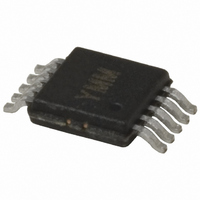MIC2169BMM TR Micrel Inc, MIC2169BMM TR Datasheet - Page 6

MIC2169BMM TR
Manufacturer Part Number
MIC2169BMM TR
Description
IC CTRLR PWM SYNC BUCK 10-MSOP
Manufacturer
Micrel Inc
Datasheet
1.MIC2169YMM.pdf
(15 pages)
Specifications of MIC2169BMM TR
Pwm Type
Voltage Mode
Number Of Outputs
1
Frequency - Max
550kHz
Duty Cycle
92%
Voltage - Supply
3 V ~ 14.5 V
Buck
Yes
Boost
No
Flyback
No
Inverting
No
Doubler
No
Divider
No
Cuk
No
Isolated
No
Operating Temperature
-40°C ~ 85°C
Package / Case
10-MSOP, Micro10™, 10-uMAX, 10-uSOP
Frequency-max
550kHz
Lead Free Status / RoHS Status
Contains lead / RoHS non-compliant
Other names
MIC2169BMMTR
MIC2169BMMTR
MIC2169BMMTR
Functional Diagram
Functional Description
The MIC2169 is a voltage mode, synchronous step-down
switching regulator controller designed for high power without
the use of an external sense resistor. It includes an internal
soft-start function (which reduces the power supply input
surge current at start-up by controlling the output voltage rise
time), a PWM generator, a reference voltage, two MOSFET
drivers, and short-circuit current limiting circuitry to form a
complete 500kHz switching regulator.
Theory of Operation
block diagram, above, illustrates the voltage control loop. The
output voltage variation due, to load or line changes, will be
sensed by the inverting input of the transconductance error
amplifi er via the feedback resistors R3, and R2 and compared
to a reference voltage at the non-inverting input. This will cause
a small change in the DC voltage level at the output of the
error amplifi er which is the input to the PWM comparator. The
other input to the comparator is a 5V triangular waveform. The
comparator generates a rectangular waveform whose width
t
t
error amplifi er. To illustrate the control loop, assume the output
voltage drops due to sudden load turn-on, this would cause
the inverting input of the error amplifi er which is a divided
down version of V
M9999-032409
The MIC2169 is a voltage mode step-down regulator. The
ON
1
, the time the triangle crosses the output waveform of the
is equal to the time from the start of the clock cycle t
0.8V
5V
Reference
Bandgap
C
IN
Digital Delay
Soft-Start &
Error
Amp
OUT
5V LDO
Counter
Enable
Error
Loop
V
5V
IN
to be slightly less than the reference
C2
0.8V
BG Valid
V
5V
DD
Clamp &
Startup
Current
COMP
R1
C1
Ramp
Clock
Current Limit
Reference
RCS
CS
V
V
REF
REF
Comparator
PWM
+3%
3%
MIC2169 Block Diagram
Comparator
Current Limit
Comparator
0
Hys
until
6
Driver
Logic
voltage. This causes the output voltage of the error amplifi er
to go high. This will also increase the PWM comparator t
time of the top side MOSFET, causing the output voltage to
go up and bringing V
Soft-Start
The COMP pin on the MIC2169 is used for the following two
functions:
For better understanding of the soft-start feature, assume V
= 12V. The COMP pin has an internal 6.5μA current source
that charges the external compensation capacitor. As soon as
this voltage rises to 180mV (t = Cap_COMP × 0.18V/8.5μA),
the MIC2169 allows the internal V
up and as soon as it crosses the undervoltage lockout of 2.6V,
the chip’s internal oscillator starts switching. At this point, the
COMP pin current source increases to 40μA and an internal
11-bit counter starts counting. This takes approximately 2ms
to complete. During counting, the COMP voltage is clamped
at 0.65V. After this counting cycle, the COMP current source
is reduced to 8.5μA and the COMP pin voltage rises from
0.65V to 0.95V, the bottom edge of the saw-tooth oscillator.
This is the beginning of 0% duty cycle which increases slowly
causing the output voltage to rise slowly. The MIC2169 has
GND
1. External compensation to stabilize the voltage
2. Soft-start.
High-Side
control loop.
Low-Side
Driver
Driver
5V
V
MIC2169
DD
SW
LSD
FB
HSD
BOOST
OUT
RSW
R2
2Ω
back in regulation.
R3
Q1
Q2
DD
1.4Ω
D1
1000pF
linear regulator to power
C
BST
L1
March 2009
V
C
OUT
OUT
ON
IN











